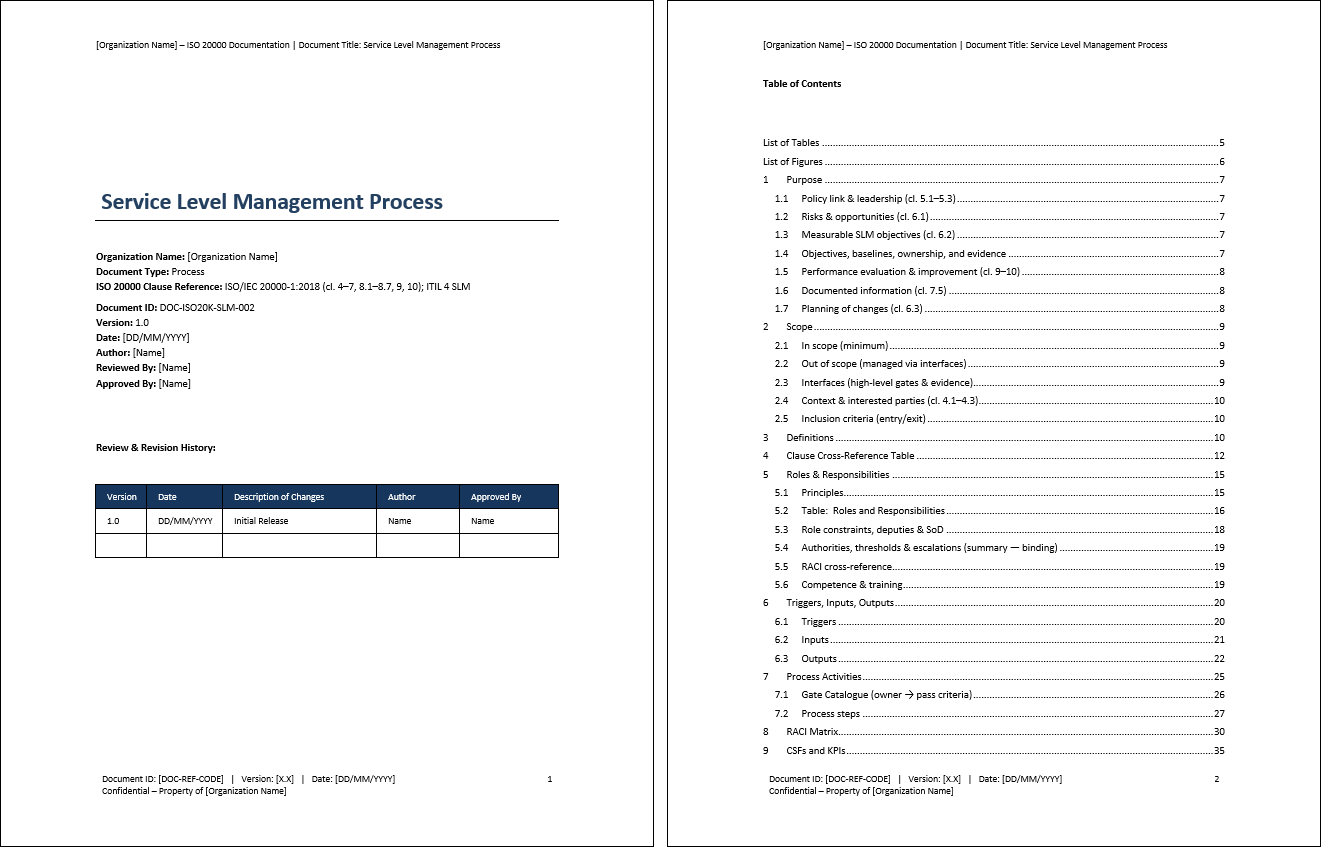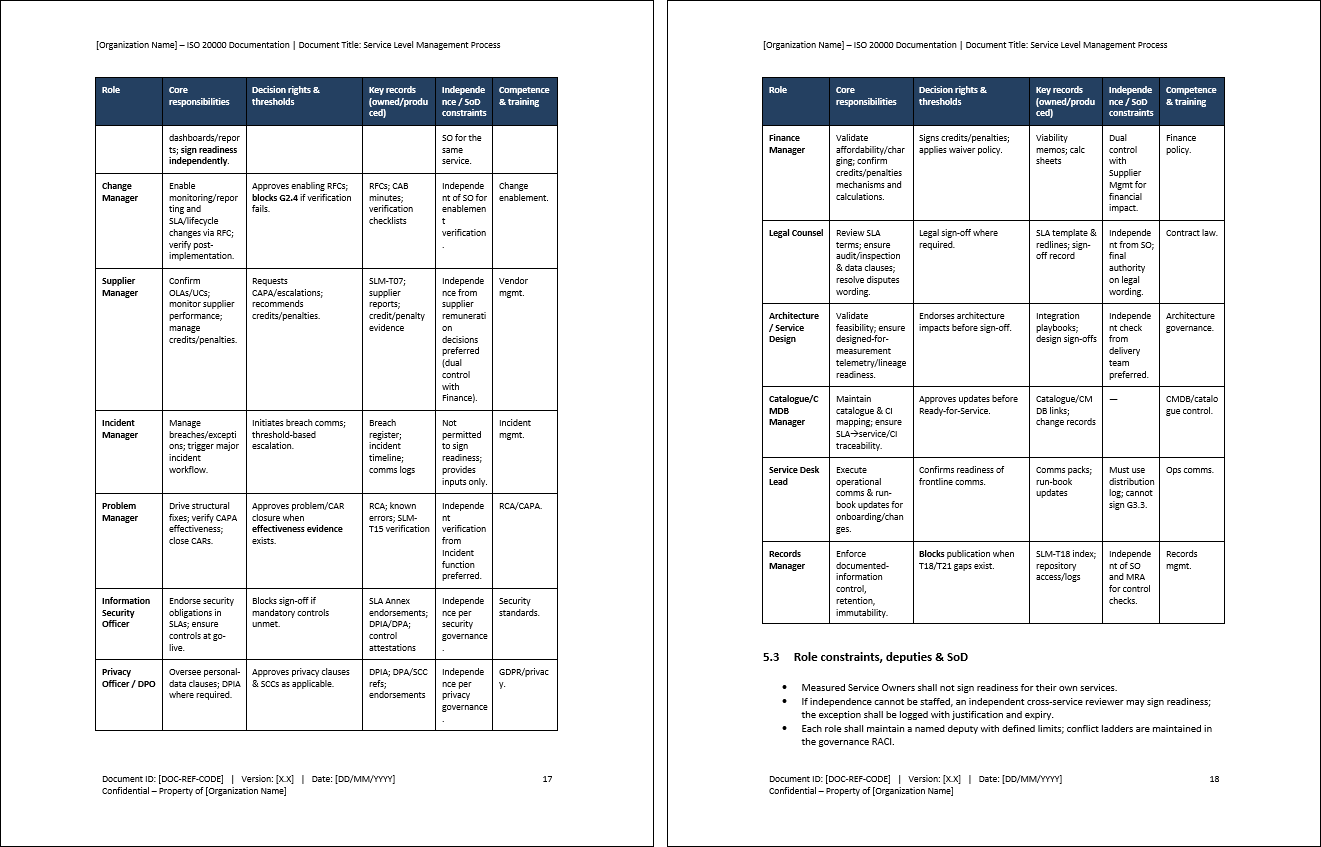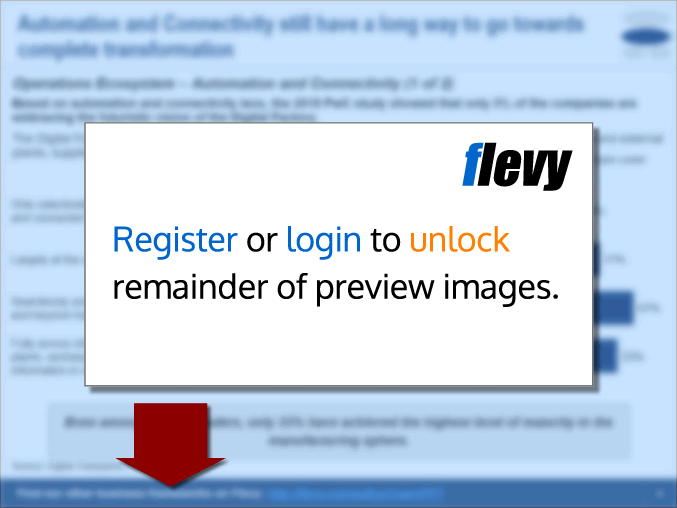Service Level Management Process (ISO 20000:2018, ITIL) (Word DOCX)
Word (DOCX) + Zip archive file (ZIP)
BENEFITS OF THIS WORD DOCUMENT
- Audit-ready from day one – Clause-mapped controls, gate evidence, and immutable records make audits predictable and defensible.
- Reliable reporting, fewer disputes – Readiness is independent and publication is blocked without lineage and snapshots, so performance conversations focus on decisions--not data debates.
- No last-minute renewals – Built-in T-180/120/90 pipeline and the ≥ T-90 decision rule keep SLA lifecycles on track with documented outcomes.
ITIL WORD DESCRIPTION
Service Level Management Process [ISO/IEC 20000-1:2018, ITIL 4]
A professionally authored, fully editable Word (DOCX) process you can download and use immediately. It provides a complete, audit-ready method to define, agree, measure, report, review, and improve service levels—aligned to ISO/IEC 20000-1:2018 Clauses 4–7, 8.1–8.7, 9, 10 and reflecting the ITIL 4 Service Level Management practice.
What it does
Establishes one governed way of working from SLR → SLA → measurement → reporting → review → lifecycle decision (≥ T-90), with hard "no-go" controls that block publication if lineage, immutable evidence, or the distribution log is missing. It standardizes time/window semantics (Europe/Berlin) and bakes in segregation of duties so readiness is signed independently.
Key features
Standards alignment, made explicit – Clause cross-reference shows exactly how SLM fulfils ISO 20000 and where the auditable evidence lives.
Gate-controlled lifecycle (G1.0–G5.1) – From Define & Plan through Agree SLAs, Monitor & Report, Review & Improve, and QA & Review—each phase has pass criteria and block authorities.
Publish-with-proof rule – No readiness if T05 lineage URIs, T21 immutable snapshots, or the distribution log are missing; independent MRA sign-off enforced.
RACI & SoD – Clear accountabilities with exactly one "A" per activity and independence for the Monitoring & Reporting Analyst; Records Manager and Change Manager hold stop-the-line powers at defined gates.
Objectives, KPIs & reaction rules – CSFs/KPIs with targets, formulas, thresholds (G/A/R), lineage references, and the discipline that Red KPI ⇒ CAR ≤ 5 business days with effectiveness verification before closure.
Records & retention – An authoritative catalogue of required records, acceptance criteria, and retention mapped to each control and template.
What's inside
End-to-end process with Purpose, Scope, Roles & Responsibilities, Triggers/Inputs/Outputs, Activities & Gate Catalogue, RACI, KPIs/CSFs, Risks & Controls, Interfaces, Internal Audit & Management Review, Training & Awareness, Tools & Automation, Continual Improvement, and Records & Audit Evidence.
Process workflow (Figure 1) and a Gate Catalogue with pass criteria and block authorities.
Template pack references (SLM-T01…T24) including SLM Policy & Objectives, Metric Dictionary, Lineage Note, SLA + Measurement & Reporting Annex, OLA/UC pack, Monthly SLA Report, Service Review Minutes, Lifecycle Decision Memo, CAR/CSI registers, MR inputs/minutes, Records & Retention Index, Training records, and more.
Appendix A – Data Model & Governance Views to standardize attributes, categorization, and dashboards/reporting.
Benefits
Audit-ready from day one – Clause-mapped controls, gate evidence, and immutable records make audits predictable and defensible.
Reliable reporting, fewer disputes – Readiness is independent and publication is blocked without lineage and snapshots, so performance conversations focus on decisions—not data debates.
No last-minute renewals – Built-in T-180/120/90 pipeline and the ≥ T-90 decision rule keep SLA lifecycles on track with documented outcomes.
Who it's for
SLM Managers/Process Owners, Service Owners, CIO/IT leaders, Monitoring & Reporting Analysts, Records & Change Managers, Security/Privacy/Legal, Internal Audit, and Risk & Compliance teams operating an ISO/IEC 20000-aligned SMS.
Get an ITIL-aligned, ISO/IEC 20000-1:2018 Service Level Management Process—editable, enforceable, and audit-ready—so you can negotiate, measure, publish, review, and improve with confidence.
Got a question about the product? Email us at support@flevy.com or ask the author directly by using the "Ask the Author a Question" form. If you cannot view the preview above this document description, go here to view the large preview instead.
Source: Best Practices in ITIL, ISO 20K Word: Service Level Management Process (ISO 20000:2018, ITIL) Word (DOCX) Document, ITSM Consulting









